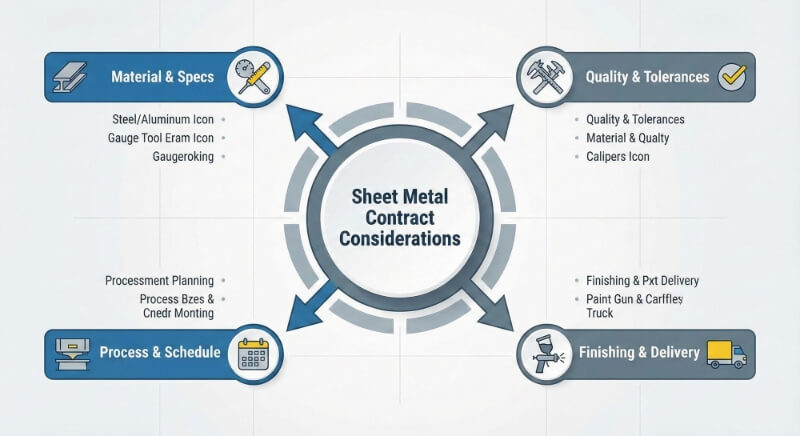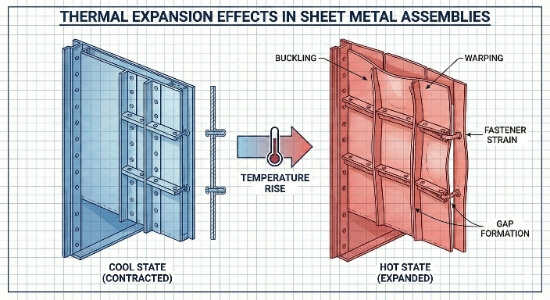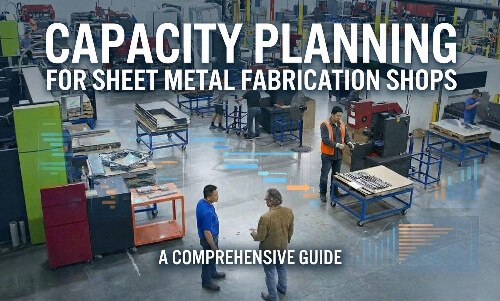Working with stainless steel sheet metal demands precision and expertise. Many manufacturers struggle to achieve clean cuts, manage costs, and maintain quality standards in their metal fabrication projects.
The best way to cut stainless steel sheet metal depends on the thickness of the material and the tools available. Tools like tin snips or a laser cutter work well for thin sheets. Thicker sheets may require a power tool such as an angle grinder with a cutting disc or a plasma cutter for precision. Always use proper safety gear when cutting stainless steel.
Let me share proven cutting methods that will transform your stainless steel fabrication process and help you always achieve professional results.
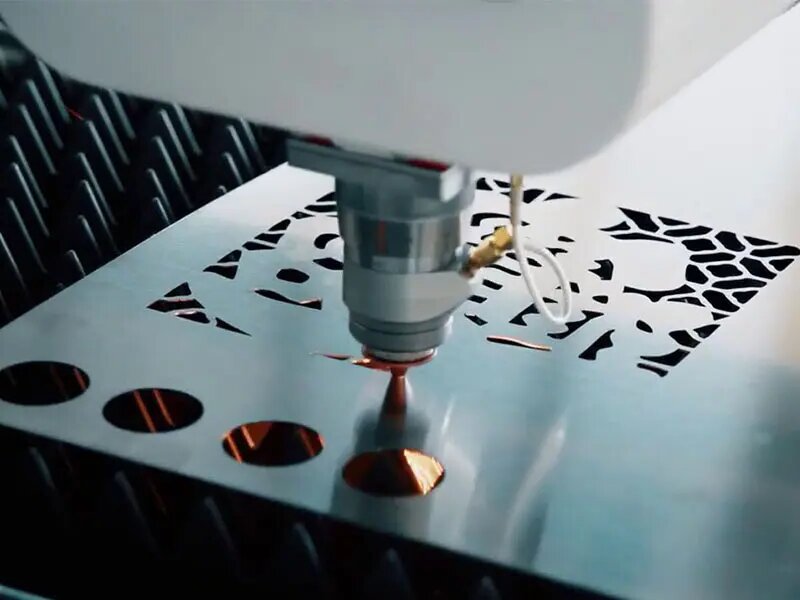
What is Stainless Steel Sheet Metal Cutting?
Stainless steel sheet metal cutting is the process of shaping and sizing stainless steel using various tools and techniques to achieve precise cuts for manufacturing and fabrication purposes. The process involves separating stainless steel sheets using various cutting methods to achieve exact dimensions and shapes.
Overview of Different Methods for Cutting Stainless Steel
Cutting stainless steel requires precision and the right tools to ensure clean edges, minimal waste, and high-quality results. Below is a detailed overview of the most common methods for cutting stainless steel sheet metal.
Shearing
Shearing is a mechanical process that uses straight blades to cut stainless steel into smaller sections. It’s ideal for making clean, straight cuts in sheet metal.
- Advantages: Fast, cost-effective, and produces minimal waste. No heat is involved, so there’s no risk of heat distortion.
- Applications: Commonly used in high-volume production environments for cutting sheets into standard sizes.
- Limitations: Not suitable for intricate designs or very hard metals.
Angle Grinding
An angle grinder uses a high-speed rotating abrasive disc to cut through stainless steel. It’s a versatile tool for both straight and complex cuts.
- Advantages: Portable, affordable, and effective for medium-thickness materials.
- Applications: Ideal for cutting pipes, rods, and sheets in construction or repair projects.
- Limitations: Requires skill to achieve precise cuts; can generate heat that may discolor the steel.
Plasma Cutting
Plasma cutting uses ionized gas (plasma) to melt through stainless steel. It’s highly effective for thick materials and intricate designs.
- Advantages: Fast, precise, and capable of cutting through thick sections. Produces minimal heat distortion.
- Applications: Used in heavy-duty industries like automotive and aerospace.
- Limitations: Requires specialized equipment and is less cost-effective for thin sheets.
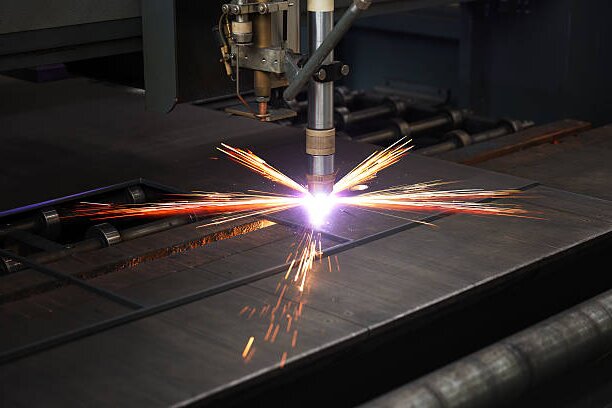
Laser Cutting
Laser cutting employs a focused laser beam to melt or vaporize stainless steel along a precise path. It’s one of the most accurate methods available.
- Advantages: High precision, clean edges, minimal heat-affected zones, and no need for secondary finishing.
- Applications: Perfect for intricate designs in industries like medical devices and electronics.
- Limitations: Higher initial equipment costs and the reflective nature of stainless steel can pose challenges.
Water Jet Cutting
Water jet cutting uses a high-pressure stream mixed with abrasive particles to erode the material. It’s a cold-cutting method that avoids heat damage.
- Advantages: No heat distortion, smooth edges, and suitable for thick materials up to several inches.
- Applications: Common in architectural and aerospace industries where precision is critical.
- Limitations: Slower than laser or plasma cutting; higher operating costs due to abrasive materials.
CNC Machines
CNC (Computer Numerical Control) machines automate the cutting process using programmed instructions. They can integrate various techniques, such as laser or plasma cutting.
- Advantages: Highly repeatable, capable of complex designs with tight tolerances, and efficient for large-scale production.
- Applications: Used in manufacturing precision components across industries like automotive and machinery.
- Limitations: Requires upfront investment in programming and equipment.
How to Cut Stainless Steel Sheet Metal?
Cutting stainless steel requires precision, preparation, and the right tools to ensure clean cuts and a safe working environment. Below is a detailed guide covering every step of the process.
Steps to Cut Stainless Steel Sheet Metal:
- Safety First: Always wear protective gear, including safety glasses, gloves, and ear protection. A clean workspace is a safe workspace!
- Mark Your Measurements: Use a permanent marker, ruler, or measuring tape to mark where you intend to cut.
- Secure the Sheet: Use clamps to fasten the stainless steel sheet to your workbench or cutting area. This prevents any unnecessary movement.
- Start Cutting: Depending on the tool you’ve chosen:
- Laser/Plasma/Water Jet Cutters: Set the parameters and let the machine do the work.
- Tin Snips: Start from an edge and cut along the marked line. Use your dominant hand to cut and the other to guide the sheet.
- Angle Grinder: Power on the grinder, let it reach full speed, and then smoothly guide it along the marked line.
5. Sanding and Finishing: There might be rough edges or burrs once your cut is complete. Using a file or sandpaper, smooth the edges for a professional finish.
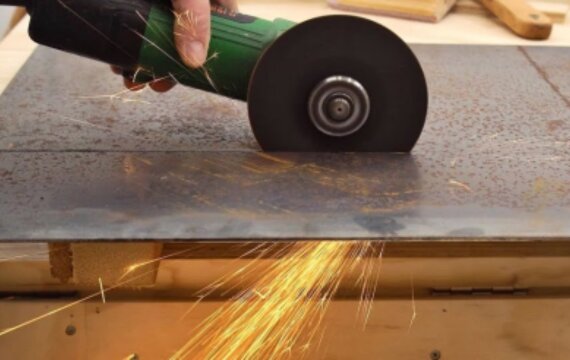
Cutting Techniques for Different Methods
How to Cut with an Angle Grinder?
- Attach an abrasive metal-cutting disc designed for stainless steel.
- Align the grinder with the marked line and start cutting steadily.
- Avoid applying excessive pressure to prevent overheating or warping.
How to Cut with a Plasma Cutter?
- Set the plasma cutter’s amperage based on material thickness.
- Position the torch at a 90-degree angle to the surface.
- Slowly guide the cutter along the marked line for clean cuts.
How to Cut with a Laser Cutter?
- Program the laser cutter with precise specifications.
- Use assist gases like nitrogen or oxygen for smoother edges.
- Allow the laser to follow the marked path for high precision.
How to Cut with a Water Jet Cutter?
- Set up the water jet machine with appropriate abrasive material.
- Adjust pressure based on material thickness (typically 50,000+ PSI).
- Guide the nozzle along the marked lines for clean, heat-free cuts.
Choosing the Right Cutting Method for Your Project
Selecting the most suitable cutting method for stainless steel sheet metal is crucial to achieving the desired results efficiently and cost-effectively. Here’s a breakdown of factors and a cost-effectiveness comparison across different methods.
Factors to Consider When Choosing a Cutting Method
Thickness of the Sheet Metal
- Thin Sheets (≤3mm): Methods like tin snips, jigsaws, or laser cutting are ideal for their precision and minimal material distortion.
- Medium Thickness (3-10mm): Circular saws, angle grinders, or plasma cutters offer efficiency and clean cuts.
- Thick Sheets (>10mm): Plasma or water jet cutting is better suited for handling thicker materials without compromising accuracy.
Desired Precision and Quality
- High Precision: Laser cutting and water jet cutting provide the best edge quality, with minimal burrs and tight tolerances.
- Moderate Precision: Plasma cutting works well for projects with acceptable slight imperfections.
- Low Precision: Saw cutting or angle grinding is sufficient for rough cuts or basic applications.
Speed and Efficiency
- Laser cutting is highly efficient for thin-to-medium-thickness materials, offering fast speeds and minimal waste.
- Plasma cutters excel in speed when working with thicker sheets.
- Water jet cutting is slower but ensures no heat-affected zones, making it ideal for sensitive applications.
Material Properties
- Stainless steel’s hardness and corrosion resistance require tools capable of handling its robust nature without overheating or warping.
- Non-thermal methods like water jet cutting are preferred when maintaining metallurgical properties, which is critical.
Comparing Cost-Effectiveness of Different Methods
| Cutting Method | Cost per Hour | Best For | Trade-Offs |
|---|---|---|---|
| Laser Cutting | $13–$20/hr | Thin-to-medium sheets, high precision | Initial equipment cost, limited thickness |
| Water Jet Cutting | $20–$40/hr | Thick sheets, no heat distortion | Slower speeds, higher operating costs |
| Plasma Cutting | $15–$25/hr | Thick sheets, fast cutting | Moderate precision, heat-affected zones |
| Angle Grinder | Low cost | Small projects, simple shapes | Requires skill, risk of uneven edges |
| Circular Saw | Moderate cost | Straight cuts on medium-thickness sheets | Limited to straight cuts |
| Tin Snips/Jigsaw | Low cost | Thin sheets, intricate shapes | Time-consuming for larger projects |
Factors Affecting the Quality of the Cut Stainless Steel
Achieving a high-quality cut in stainless steel sheet metal depends on multiple factors, including heat management, edge quality, and minimizing burr formation. Below is an in-depth look at these critical aspects.
Heat Generation and Its Impact on the Material
Challenges
- High temperatures during cutting can cause heat discoloration, warping, and structural changes in stainless steel.
- The heat-affected zone (HAZ) can weaken the material’s properties, such as fatigue and corrosion resistance.
Solutions
- Cooling Techniques: Use coolants or cutting fluids to dissipate heat and prevent discoloration or warping.
- Optimized Cutting Parameters: Adjust speed, feed rate, and depth of cut to reduce heat buildup. For example, slower speeds may minimize overheating but require careful balance to avoid inefficiency.
- Non-Thermal Methods: Techniques like water jet cutting entirely avoid heat distortion using cold cutting processes.
Maintaining Edge Quality and Avoiding Distortion
Challenges
- Poor edge quality can result from uneven cuts, thermal distortion, or improper tool selection.
- Distortion occurs when excessive heat causes uneven expansion and contraction of the metal.
Solutions
- Tool Selection: Use sharp tools with proper coatings to ensure clean cuts. For example, laser cutters with high beam quality deliver smooth edges.
- Edge Precision: Methods like laser or water jet cutting provide tight tolerances and minimal kerf width for superior edge finishes.
- Material Handling: Secure the sheet firmly with clamps to avoid movement during cutting.
Reducing Burrs and Sharp Edges
Challenges
- Burrs are raised edges or small pieces of material left on the cut surface. They affect dimensional precision, aesthetics, and safety.
- Burrs often form due to improper cutting speeds, low-quality tools, or insufficient gas flow in processes like laser cutting.
Solutions
- Auxiliary Gases: Use high-purity gases like nitrogen in laser cutting to blow away molten material effectively. This reduces burr formation at the cut edges.
- Parameter Optimization: Fine-tune cutting parameters such as speed, power, and focus position to minimize burrs.
- Post-Cutting Deburring: Employ manual tools (files or sandpaper), rotary deburring tools, or vibratory finishing to smooth out any remaining burrs.
Conclusion
Cutting stainless steel sheet metal with precision and efficiency is crucial for achieving high-quality results in your projects. By selecting the right method and following best practices, you can ensure clean cuts, maintain material integrity, and meet your specific requirements.
Are you looking for professional stainless steel cutting services? Contact us today to discuss your project needs and request a customized quote. Let’s work together to bring your ideas to life!
FAQs:
Can You Cut Stainless Steel with a Regular Saw?
Yes, but you need a metal-cutting blade specifically designed for stainless steel. Using a regular saw without the proper blade can damage the tool and the material.
How Do You Prevent Stainless Steel from Warping During Cutting?
To prevent warping, use cooling methods like water or air to dissipate heat, cut at higher speeds to reduce heat buildup, and secure the material firmly to minimize movement.
What is the Best Way to Cut Stainless Steel Sheets?
Laser cutting is the best method for thin-to-medium sheets due to its precision and minimal waste. For thicker sheets, plasma or water jet cutting ensures clean cuts without compromising material integrity.
Hey, I'm Kevin Lee

For the past 10 years, I’ve been immersed in various forms of sheet metal fabrication, sharing cool insights here from my experiences across diverse workshops.
Get in touch

Kevin Lee
I have over ten years of professional experience in sheet metal fabrication, specializing in laser cutting, bending, welding, and surface treatment techniques. As the Technical Director at Shengen, I am committed to solving complex manufacturing challenges and driving innovation and quality in each project.

